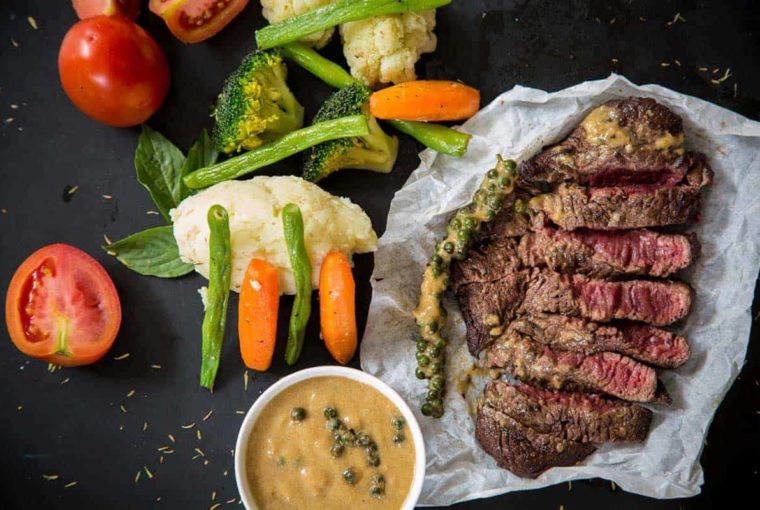Do you know there’re few nutrients as essential as protein to the human body? Protein is not just like every other nutrient. It’s the body’s primary building block.
When you don’t get enough protein from meals or other sources, your body composition and health pay the ultimate prize.
So how much protein is ideal to have daily? This post takes a look at the amount of protein required daily and many more.
Protein – How Vital Is It?
Have you heard the word “protein is king”? Protein does a lot in our bodies.
Your body needs protein to make muscles. That’s why the more you exercise, the higher your protein needs. Endurance and resistance training can quickly break down protein in the muscle.
Protein consists of amino acids. It’s also essential in making tendons, skin, internal organs, neurotransmitters, enzymes, and even hormones. It builds organs that serve critical functions in the body.
Put simply, our body’s function and structure depend massively on proteins. Tissues, cells, and organ regulation cannot take place without them. Humans need proteins to live.
Signs Of Low Protein
The body has a way of reacting when we don’t consume enough protein. And some of the signs are visible.
Here are signs that your body isn’t getting enough protein.
1. Swelling:
Also called edema, swelling can occur in your abdomen, hands, legs, or feet. It is one of the visible signs that your body isn’t getting enough protein.
Other factors can cause edema. So, if you have edema and you’re sure of adequate protein intake, seek medical attention. The swelling might not be protein-related.
Albumin is the protein responsible for preventing fluid buildup in tissues, which causes swelling. It is usually circulated in the blood.
The liver produces albumin, a protein that keeps fluids in one’s bloodstream, preventing them from leaking into tissues to cause swelling.
Albumin also transports several substances throughout the body. These include enzymes, vitamins, and hormones.
2. Mood swing;
If you want to control your mood, take care of your protein intake. Why? Protein helps the brain to function as it should.
The chemicals, neurotransmitters, are vital to the brain. The brain uses them to transport information between cells.
Amino acids are responsible for producing neurotransmitters. Thus, zero or low protein in your diet means your body will no longer have the capacity to produce enough neurotransmitters, which will, in turn, change how your brain functions.
Low levels of serotonin and dopamine can leave you feeling overly aggressive or depressed. But keep in mind that other factors can make you feel this way, not just protein.
3. Nail, hair and skin conditions;
Take a look at your skin. Is it dry and flaky? Protein might be the culprit.
Your nails, hair, and skin are made up of proteins. These include collagen, elastin, and keratin. Your body needs to manufacturer enough of these proteins to keep your nails, hair, and skin glowing.
Protein can encourage hair growth and stop hair loss.
If your body can’t manufacture enough of these proteins, your hair, skin, and nails will suffer. Expect thinning or brittle hair.
Your skin can become flaky and dry, while nails can develop deep ridges.
Keep in mind that a protein-rich diet isn’t the only thing to blame for these conditions.
4. Fatigue and weakness
Lack of protein can cause you to lose muscle mass. And this also can cut your strength, slow down metabolism, and make keeping your balance difficult.
5. Hunger
Hunger is one of the most obvious signs of low protein. That’s because protein serves as fuel to your body.
Studies have confirmed that eating protein-rich food can make you feel fuller for an extended period. It helps take care of obsessive thoughts about food.
Eating less is also a good way to lose weight.
6. Feeling or staying sick
Protein can impact your health significantly, not just mood. You need it to digest and absorb several nutrients the body requires to stay strong.
The amino acids you have in your blood help your immune system manufacturer antibodies, stimulating the white blood cell to fight bacteria, toxins, and viruses.
How You Can Calculate Protein Needs
Step#1 – Convert your weight in kg and multiply with the number of protein per kilograms.
Consider converting your weight from pounds to kilograms (kg).
If you already know what you weigh in kilograms, just skip this part and proceed to the main calculation.
Note: To convert your weight in kilograms, divide your weight in pounds by 2.2.
For example, assuming you weigh 154lb (pounds). Your weight in kilograms will be 154/2.2 = 70 kg.
Your next step is choosing the amount of protein per kg of bodyweight. Here’s how to get this done.
- People in good health, but live sedentary lifestyles use the range’s low end, which is 0.8g per kilogram.
- People under stress, recovering from illnesses, pregnant or regularly indulge in intense endurance or weight exercises, can use a much higher number (1.2 and 2.0).
So, how can you determine your daily protein intake? Once you know your weight in kilograms, multiply that figure by the protein grams per day.
Note: Don’t rule out visiting a nutritionist or doctor. You may need either’s advice on how to determine the protein grams per day.
Step#2 – Using calories
Here’s another exciting way to determine your daily protein needs. It is simple and straightforward.
Under this procedure, you need to use daily calorie consumption and the percentage of the calories you’ll get from protein.
First, determine the number of calories your body requires daily to maintain what you currently weigh.
You need to do three things;
1. Determine your BMR (Basal Metabolic Rate). You can calculate it using a BMR calculator.
2. Determine the calories you burn daily, based on your physical activities.
3. Add numbers 1 and 2. That is, add your BMR to the number of calories you burn daily.
With the above calculation, you can determine the number of calories your body requires daily to maintain your weigh.
Furthermore, you need to determine your diet’s percentage that comes from protein. The percentage will be based on several factors. These include your fitness level, body type, goals, and metabolic rate.
The American Dietary Guideline, 2015 to 2020, recommends that protein should make up 10 and 35 percent for adults.
Now, multiply this percentage by the total amount of calories needed daily. You’ll get the total number of daily calories derived from protein.
The final step is to divide whatever figure you arrived at by 4.
Protein And Its Negative Health Effects
Name one unfairly treated nutrient, and protein comes to mind. There are claims that high protein diets are dangerous to health.
According to these claims, such high-protein diets can cause osteoporosis and kidney damage. But these are just mere assumptions. They’re not backed by science.
For individuals with a pre-existing kidney issue, limiting your protein intake might be helpful. However, the case is different if you’re healthy. In healthy individuals, protein does not cause kidney damage. No study supports this claim.
Protein helps prevent kidney problems in ways you never imagined. Intake of protein-rich diets, according to research, lowers blood pressure and proves helpful in the fight against diabetes.
High blood pressure and diabetes have been directly linked to kidney diseases. So, if you’re a healthy individual, you’re doing your health and vital organ a world of good by consuming protein.
So these are just mere allegations against proteins, a nutrient that keeps the body healthy. For instance, there’re claims that protein can cause osteoporosis. But studies have proven that protein can prevent the disease.
Therefore, protein doesn’t have any adverse effects backed by science. However, too much of everything is terrible. Just make sure you consume the required amount.
How To Boost Protein Intake
The importance of protein cannot be overemphasized. You need to get enough protein to maintain good health.
Protein is also essential to achieving your weight loss goals. It can help you lose weight and build muscle mass.
The RDI (Recommended daily intake) of protein, according to studies, is 50 grams. However, experts still believe that many individuals should be getting enough of this recommended amount per day.
Here are tips to get more protein daily.
1. Use eggs in place of cereals
Eggs can quickly improve your protein intake. For instance, three eggs offer a whopping 19 grams of protein.
So if you want to increase daily protein intake, use eggs in place of low-protein diets. Examples of such breakfast foods low in protein are cereals, bagels, and toast.
Studies have also proved that eggs reduce appetite. Eating eggs for breakfast will make you feel fuller for many hours, reducing your daily calorie intake.
2. Consume Greek yogurt
Greek yogurt has a rich source of protein. It is used to substitute sour cream in sauces, dips, and other recipes.
You can consume Greek yogurt alone or have it added to other foods. Greek yogurt also contains double of what the traditional protein yogurt has.
3. Combine high protein foods to salad
Salads come packed with vegetables that contain minerals, antioxidants, and nutrients. All of these help us maintain good health and prevent diseases. Antioxidants, for example, prevent free radical damages.
Even with all the nutrients and minerals that salad contains, its protein content isn’t encouraging. Hence, when you eat salad, you may start to feel hungry in two hours or less.
The best way to consume salad and maintain high protein intake is to incorporate protein-rich foods in your salads. Examples include turkey or chicken breasts, tuna, cheese, and salmon.
Turkey or chicken breast, for instance, contains 30 grams of protein. Cheese, on the other hand, can offer you 22 grams of protein.
4. Incorporate high-protein foods in each meal
It’s good to achieve the recommended daily protein intake, which is 50 grams. However, achieving this amount in one large meal isn’t the best option. Instead, ensure each meal includes foods that are high in protein.
You can combine foods that offer at least 20 – 30 grams of protein in each meal. There’s nothing wrong with that. It’s even more beneficial, according to studies. Such meal combinations will help you stay fuller for an extended period and maintain your muscle mass.
5. Combine fruits with peanut butter
Fruits are delicious and contain diverse nutrients, minerals, and antioxidants, which the body needs. But they’re low in protein. Hence, there’s a need to combine fruits with protein-rich foods.
Incorporating two teaspoons of peanut butter on firm fruits like apple or pear can raise their protein content by 8 grams.
Peanut butter is not just delicious. It offers enormous health benefits. It can reduce your appetite, encourage heart health, and lower blood sugar considerably.
6. Try some canned fish
You can enhance protein intake by adding canned fish to your meal plans.
The good thing about canned fish is that you can travel along with it. It has a stable shelf-life and doesn’t require refrigeration. The only way it can start deteriorating is when the can is opened.
Excitingly, you can eat canned fish as a snack or have it added to your meals. A 3.5-oz or 100 grams serving of the canned fish offers 20 to 25 grams of protein.
Canned fishes offer enormous health benefits that make them a wise choice to consume. Examples of some of the fishes used are sardines, herring, mackerel, and salmon.
These fatty fishes are excellent sources of omega-3 fatty acids. And omega-3 helps to prevent inflammation and promote heart health.
Conclusion
What’s your protein intake? If you’ve not been keeping tabs on your protein intake, now is the right time. Ensure you’re consuming enough protein, because it is vital to your health.
Remember, high protein intake can help you achieve your weight loss goal in no time, promote metabolic health, and increase muscle mass.




